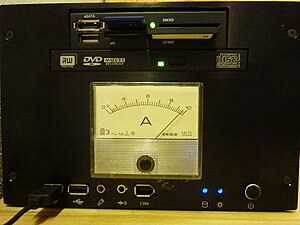AMMETER
"Amperemeter" redirects here. For the unit of measurement, see Ampere-meter.
An ammeter is a measuring instrument used to measure the electric current in acircuit. Electric currents are measured in amperes (A), hence the name. Instruments used to measure smaller currents, in the milliampere or microampere range, are designated as milliammeters or microammeters. Early ammeters were laboratory instruments which relied on the Earth's magnetic field for operation. By the late 19th century, improved instruments were designed which could be mounted in any position and allowed accurate measurements in electric power systems.
History[edit]
The relation between electric current, magnetic fields and physical forces was first noted by Hans Christian Ørsted who, in 1820, observed a compass[1]
needle was deflected from pointing North when a current flowed in an adjacent wire. The tangent galvanometer was used to measure currents using this effect, where the restoring force returning the pointer to the zero position was provided by the Earth's magnetic field. This made these instruments usable only when aligned with the Earth's field. Sensitivity of the instrument was increased by using additional turns of wire to multiply the effect – the instruments were called "multipliers".Types[edit]
Moving-coil[edit]
The D'Arsonval galvanometer is a moving coil ammeter. It uses magneticdeflection, where current passing through a coil causes the coil to move in amagnetic field. The modern form of this instrument was developed by Edward Weston, and uses two spiral springs to provide the restoring force. The uniform air gap between the iron core and the permanent magnet poles make the deflection of the meter linearly proportional to current. These meters have linear scales. Basic meter movements can have full-scale deflection for currents from about 25microamperes to 10 milliamperes.[2]
Because the magnetic field is polarised, the meter needle acts in opposite directions for each direction of current. A DC ammeter is thus sensitive to which way round it is connected; most are marked with a positive terminal, but some have centre-zero mechanisms[note 1] and can display currents in either direction. A moving coil meter indicates the average (mean) of a varying current through it,[note 2] which is zero for AC. For this reason moving-coil meters are only usable directly for DC, not AC.
This type of meter movement is extremely common for both ammeters and other meters derived from them, such as voltmeters and ohmmeters. Although their use has become less common in recent decades, this type of basic movement was once the standard indicator mechanism for any analogue displays involving electrical machinery.
d permanent magnet to provide the restoring force.
Electrodynamic[edit]
An electrodynamic movement uses an electromagnet instead of the permanent magnet of the d'Arsonval movement. T
Moving magnet[edit]
Moving magnet ammeters operate on essentially the same principle as moving coil, except that the coil is mounted in the meter case, and a permanent magnet moves the needle. Moving magnet Ammeters are able to carry larger currents than moving coil instruments, often several tens of Amperes, because the coil can be made of thicker wire and the current does not have to be carried by the hairsprings. Indeed, some Ammeters of this type do not have hairsprings at all, instead using a fixehis instrument can respond to both alternating and direct current[2] and also indicates true RMS for AC. See Wattmeter for an alternative use for this instrument.
Moving-iron[edit]
Moving iron ammeters use a piece of iron which moves when acted upon by the electromagnetic force of a fixed coil of wire. This type of meter responds to both directand alternating currents (as opposed to the moving-coil ammeter, which works on direct current only). The iron element consists of a moving vane attached to a pointer, and a fixed vane, surrounded by a coil. As alternating or direct current flows through the coil and induces a magnetic field in both vanes, the vanes repel each other and the moving vane deflects against the restoring force provided by fine helical springs.[2] The deflection of a moving iron meter is proportional to the square of the current. Consequently such meters would normally have a non linear scale, but the iron parts are usually modified in shape to make the scale fairly linear over most of its range. Moving iron instruments indicate the RMS value of any AC waveform applied.
The moving-iron meter was invented by Austrian engineer Friedrich Drexler in 1884.[3]
Hot-wire[edit]
In a hot-wire ammeter, a current passes through a wire which expands as it heats. Although these instruments have slow response time and low accuracy, they were sometimes used in measuring radio-frequency current.[2] These also measure true RMS for an applied AC current.
Digital[edit]
In much the same way as the analogue ammeter formed the basis for a wide variety of derived meters, including voltmeters, the basic mechanism for a digital meter is a digital voltmeter mechanism, and other types of meter are built around this.
Digital ammeter designs use a shunt resistor to produce a calibrated voltage proportional to the current flowing. This voltage is then measured by a digital voltmeter, through use of an analog to digital converter (ADC); the digital display is calibrated to display the current through the shunt. Such instruments are generally calibrated to indicate the RMS value for a sine wave only but some designs will indicate true RMS (sometimes with limitations as to wave shape).






No comments:
Post a Comment